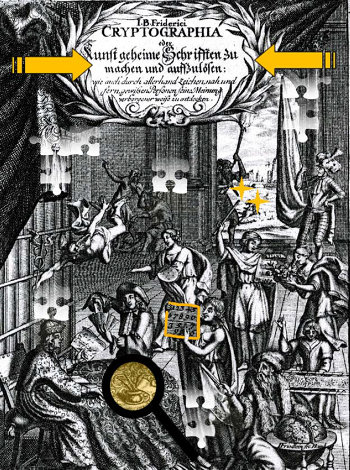Word just arrived here by breathless carrier pigeon (well, the little chap had flown from Italy, after all) about a conference in Gotha on 14th-16th February 2013 (yes, this very week!) on historical cryptography. And here’s the rather nice conference artwork:-
Lots of interesting sessions on all manner of European historical stuff, such as from top Italian cipher-breaker Filippo Sinagra, who you may remember from the Nat Geo “Ancient X-Files” Voynich half-episode not so long ago. Filippo’s talk is on Sforza-era cryptography, for which he patiently trawled through the Milanese archives (he very kindly passed me scans a while back). Fascinating stuff that’s right up my street, I just wish I could be there (though sadly that’s not possible this particular time, oh well!)
There’s also a talk on historical code-breaking methodology (or, more accurately, the apparent lack of anything like one) being given by a certain German cipher skeptic – yes, it is indeed that man again, Klaus Schmeh. His introduction notes that: “Publications devoted to the particular methods of cryptanalysis regarding historical ciphers are rare. The presence of numerous works in which decrypted historic secret texts are presented should not obscure the fact that a comprehensive theory is lacking in this area.” Amen to that, Brother Klaus!
Another nice thing is that Christiane Schaefer will be discussing the Copiale Cipher (which she, Beáta Megyesi and Kevin Knight successfully broke) and her team’s follow-on project, an “interactive digital platform” called “CADMUS” for early modern cryptology. All of which sounds a lot like a call to European historians to send them your enciphered early modern documents and they’ll crack ’em… or you could just send them to me c/o Cipher Mysteries, that would work too. 😉
But perhaps the wild-card of the conference will prove to be Dr. Michael Korey, whose session is intriguingly entitled “Hidden steganography and burned substitution. Some little‐known cypher equipment from the cabinet of curiosities (Kunstkammer) of Dresden”. The description (which I hope it’s ok to reproduce here) goes like this:-
“In the middle of the 16th century, the German territories were considered to be not very progressive by foreign countries in regard to their ability to encrypt their messages or decrypt those sent by others. Matteo Argenti, secretary of cyphers at the Vatican, said the Germans and their neighbours understood so little about cyphers that they preferred to shred and burn the encoded dispatches they received instead of trying to decrypt them. In retrospect, this assessment seems quite premature, considering two pieces coming from the electoral Saxon cabinet of curiosities (Kunstkammer), that so far have not attracted much attention and will be presented here.”
It should be no surprise that I rather like the sound of that. Ummm… I hope someone takes a photo or two (hint, Klaus, *cough*). 🙂
For everyone going, I hope you have a great time, it looks like a great conference!

How tooth-gnashing not to have heard sooner.
Also, btw, link “c/- ciphermysteries” works only for IE browsers I think.
Hi Nick
Inside that book is another engraving that conceals the message ‘unser cmmendant ist tod’ in the eyes of the people. animals and fruit – I assumed this frontspiece hides a message in the tips of pointing things, but was not able to find it.
Do you know of its solution?
Tony
Tony: no, I don’t know, but I’ll ask Klaus – it may well have been chosen at the specific suggestion of someone attending the conference, and as an attendee he’ll be in a good position to ask. 🙂
Nick, will Klaus be filling you in on the details of this meeting, when he visits with you in March? Fascinating!
This seemed a fair place to note that many of the ‘ancient magical scripts’ which appear in seventeenth century works, (especially German ones for some reason) are actually based Samaritan, or Hebrew script with ornamental twiddlys added.
Nice clip from
Wilhelm Schickard’s Bechinath Happeruschim (1624),
and then
Johannes Leusden’s Philologus Hebraeo-mixtus (1699).
PLUs (yes, there’s more)
the first glimmerings of palaeography –
in
Valentin Ernst Loescher’s De causis linguae hebraeae (1706) and Adriaan Reland’s Antiquitates sacrae veterum Hebraeorum (1712).
all in a single post here:
Enjoy!
http://onthemainline.blogspot.com.au/2009/10/on-european-knowledge-of-ancient-hebrew.html
I created a theoretical concept to decipher lesbians cryptic language in Calabar, Nigeria. I tagged the concept as “Semiotic and linguistic cryptanalysis:” I will send you the paper when it is published Thanks. How do we call the “spoken cypher”?
Waliya Yohanna Joseph: what you’re talking about is probably more like a (word-based) code than a (letter-based) cipher, and indeed closer to a slang, backslang, cant, argot or even pidgin. There is a good-sized literature on those, such as Cockney rhyming slang and (perhaps most relevant to your interest) Polari:
https://en.m.wikipedia.org/wiki/Polari
I am very much grateful for your excellent idea and quick response. Prof. Thanks